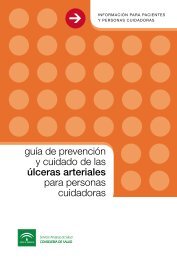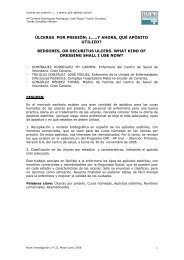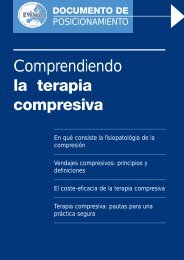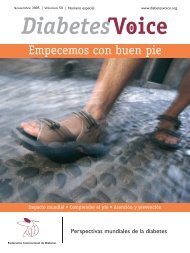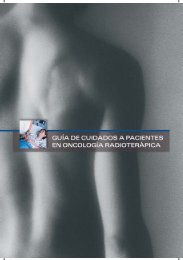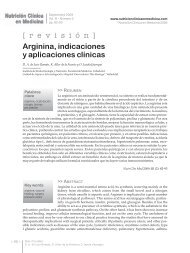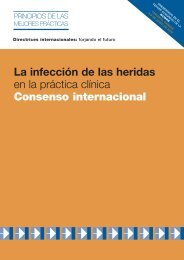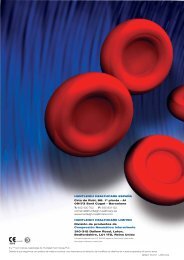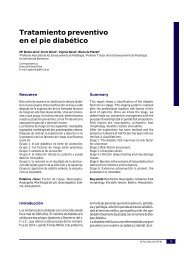DIABETIC ANGIOPATHY ■ 25Glycemic controlIn the initial approach of a patient with adiabetic foot ulcer aggressive metabolic controlis often necessary. Infection can causediabetes decompensation requiring intensivemonitorization and commonly, optimalgycemic control can only be achieved aftersurgical débridement and institution of broadspectrumantibiotic therapy.Treatment of infectionPatients with limb-threatening infectionsrequire immediate hospitalization, immobilization,and intravenous antibiotics. Culturesfrom the depths of the ulcer should be sent;wound swabs are unreliable and should not beperformed. Empiric broad-spectrum antibiotictherapy should be initiated to cover thepolymicrobial infections, including anaerobicgerms usually seen in diabetic patients. Empiricantibiotic regimens are dictated by institutionalpreferences, local resistance patterns,availability, and cost. Early detection of infectionis of paramount importance and sophisticatedimaging of the foot through MRI or CTScan may be required to confirm earlychanges such as fluid collections, abcesses,erosion of soft tissues and of bone structures,which are missed on plain X Rays of the foot(21).Patients with abscess formation or necrotizingfasciitis must undergo prompt incision,drainage, and full débridement, including partialopen toe, ray, or forefoot amputation. Tendonsheaths should be probed as proximallyas possible and excised if infected. These proceduresmust be promptly performed in patientswith active infections before any vascularintervention and should not be delayed byany imaging investigation for revascularizationplanning.RevascularizationRevascularization should be consideredfor all patients with significant occlusive diseaseand diabetic foot ulcers. Recent studieshave shown that diabetic patients with CLIcould benefit from revascularization, regardlessthe technique used, with significantimprovements in limb salvage and survivalrates (4,7).The choice of a revascularization proceduredepends on the severity of the limb ischemia,the general condition, surgical risk assessmentand life-expectancy of the patient,anatomic location and distribution of arteriallesions and availability of venous conduit(22).The conjugation of these factors allow a tailoredapproach for each patient, that can includesurgical revascularization, endovascular,hybrid procedures or, in the severely ill andimmobilized patient with extensive arterial lesions,primary amputation. Based on extensivereview of studies, TASC introduced a classificationsystem that stratifies the anatomic patternof lesions in four groups according to thebest method of revascularization, whereasgroups A and B favor endovascular interventionand C and D open surgery.Open Surgery: Open surgery procedures,like bypass or endarterectomy, havebeen the classic revascularization approachfor CLI. The same surgical principles used forrevascularization in non diabetic patientsare applied for diabetic patients (23). Althoughthe anatomical pattern of arterial diseasefrequently involves crural vessels and performanceof ultradistal bypasses (to pedalarte ries) has been associated with excellentoutcome (24) (Fig. 3), the concomitant presenceof occlusive and calcified plaques in thecommon femoral artery requires conventionalendarterectomy(25) which may act as theentry gate to proximal and distal endovascularprocedures .Success of a distal bypass procedure hasfew requirements: adequate inflow, suitableconduit availability and appropriate outflow.DM-related PAD typically spares the aorto-iliacterritory, although multilevel disease iscommon, specially when multiple risk factorsare present. In the latter cases a combinedproximal and infra-inguinal revascularizationmay be necessary to provide adequate flow
26 ■ PIE DIABÉTICOfor healing of extensive, non-demarcated footulcerations. Concerning the adequacy of theconduit, the great saphenous vein is the mostused (fig. 4) and it provides the best long-termpatency and limb salvage rates (26).Figure 4. Control angiogram of a femoro-poplitealbelow-knee bypass.Other vein grafts, like small saphenousvein, spliced veins, upper limb veins and syntheticconduits like PTFE are alternatives withsignificantly worse results. Performance oftechnical adjuvants as the Miller or St.Mary’scuff to improve patency of synthetic grafts inthe absence of a suitable vein has been describedand seems associated with better limbsalvage rates (fig. 5).salvation rates close to 90% at one year andaround 75% at 5 yrs follow-up (4, 22). Howevera close surveillance program and aggressivere-intervention policy should be implementedto ensure clinical success (27).Endovascular Surgery: many authors nowconsider percutaneous transluminal angioplasty,with or without stenting to be the first lineapproach for CLI because clinical results aresimilar to open surgery and it potentially offersadvantages such as minimal access trauma, lowinfection rates and shorter hospitalization (7,28-29). New advances in the technology of endovasculardevices expanded even further thepossibilities of endovascular intervention. Dedicatedguidewires, catheters and sheaths tochronic total occlusions, lower profile ofballoons and better designed stents, drug-elutingballoons and stents, stentgrafts, etc openedthe possibility of successful treatment of calcifiedarteries and extensive occlusions, frequentlyobserved in diabetic patients, achievingacceptable patency rates compared to openbypass. Endovascular interventions can also betailored to each case, allowing revascularizationof targeted tibial and pedal arteries thatprovide flow to specific regions of the foot(angiossome theory) thus providing optimalflow for healing specific lesions (28, 30).Figure 5. A Miller’s cuff.The distal artery to act as receptor of abypass should be selected preferably in relationto its integrity and ability to provide directflow to the pedal arch or, in alternative,the one with a better collateralization <strong>net</strong>workto the foot.Primary patency rates for open surgeryin diabetic patients, although reduced in comparisonto nondiabetics, can provide limbFigure 6. Angioplasty of an extensive occlusion ofthe tibio-peroneal trunk.





